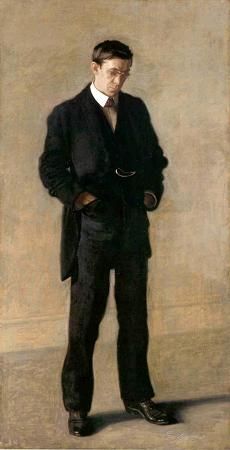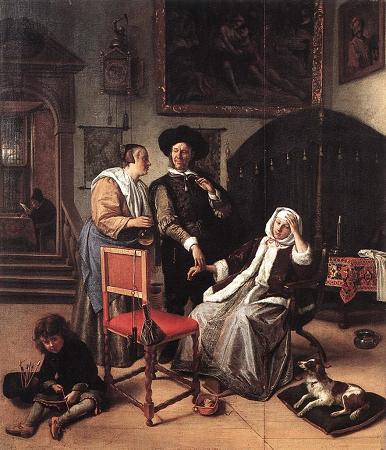Agnew Clinic (1889). Oil on canvas. 214 x 300. University of Pennsylvania, Philadelphia. The Agnew Clinic is an 1889 oil painting by American artist Thomas Eakins. It was commissioned to honor anatomist and surgeon David Hayes Agnew, on his retirement from teaching at the University of Pennsylvania. The Agnew Clinic depicts Dr. Agnew performing a partial mastectomy in a medical amphitheater. He stands in the left foreground, holding a scalpel. Also present are Dr. J. William White, applying a bandage to the patient; Dr. Joseph Leidy, taking the patient's pulse; and Dr. Ellwood R. Kirby, administering anesthetic. In the background, the operating room nurse, Mary Clymer, and University of Pennsylvania medical school students observe. Eakins placed himself in the painting-he is the rightmost of the pair behind the nurse-although the actual painting of him is attributed to his wife, Susan Macdowell Eakins. The painting, also, records the significant transition, in just 14 years, from the earlier status quo-the participants' black frock coats represented in The Gross Clinic-to the white coats of 1889. The painting is Eakins's largest work. It was commissioned for $750 in 1889 by three undergraduate classes at the University of Pennsylvania, to honor Dr. Agnew on the occasion of his retirement. The painting was completed quickly, in three months, rather than the year that Eakins took for The Gross Clinic. Eakins carved a Latin inscription into the painting's frame. Translated, it says: D. Hayes Agnew M.D. Most experienced surgeon, clearest writer and teacher, most venerated and beloved man. The work is a prime example of Eakins's scientific realism. The rendering is almost photographically precise-so much so that art historians have been able to identify everyone depicted in the painting, with the exception of the patient. It largely repeats the subject of Eakins's earlier The Gross Clinic, seen at the Philadelphia Museum of Art. The painting echoes the subject and treatment of Rembrandt's famous Anatomy Lesson of Dr. Nicolaes Tulp, and other earlier depictions of public surgery such as the frontispiece of Andreas Vesalius's De humani corporis fabrica, the Quack Physicians' Hall by the Dutch artist Egbert van Heemskerck, and the fourth scene in William Hogarth's The Four Stages of Cruelty. Students of the medical class of 1889 who commissioned The Agnew Clinic are portrayed as the audience for the surgery, as historian Amanda Mahoney points out, all individuals depicted in the work can be identified by name, except for the patient, and this audience of male medical students creates a composition that highlights power dynamics between the masculine and the feminine in the academic medical hierarchy. Central to the medical care of the patient yet separate in her femininity stands the woman in white, the nurse, Mary Clymer, who serves as the surgeon Agnew's structural counterpart in the composition of the painting, the only other figure on the same level as the surgeon. Credited by the Hospital of the University of Pennsylvania as the first trained operating room nurse in Philadelphia, Mary V. Clymer was born in Mercer County, New Jersey, in 1861 to a prominent Civil War veteran. At the age of 28, Clymer enrolled in the Hospital of the University of Pennsylvania Training School for Nurses. Graduating in 1889 at the top of her class, Clymer was among the first graduates of HUP's nurse training school, which was established in 1886. Clymer was the recipient of the Nightingale Award for her exceptional patient care and scholarship. Fittingly, Clymer missed her graduation ceremony from the Training School because she was providing emergency care to victims of the 1889 Williamsport flood Some art historians read Clymer's presence in the painting as sympathetic to the female patient: Clymer looks down at the objectified female figure and feels connection with another body separate from the male-dominated hospital hierarchy. Others argue that Clymer's presence challenges this dynamic: Clymer's presence demonstrates the increasing technical advancements within nursing and medicine, her placement in the scene is a nod to the contributions to sanitation and organization that nurses brought to the operating room. Clymer may not look down at the female figure in sympathy but with the cool attention of a trained operating room nurse, one who closely monitors her patient's status and anticipates the needs of the surgical team. Founded in 1878 and opened in 1886, the HUP Training School for Nursing engaged nursing students in rigorous hands-on and lecture-based learning. During the first month of nursing training, probationers began their nursing education providing dietary and cleaning services at the hospital.
more...



